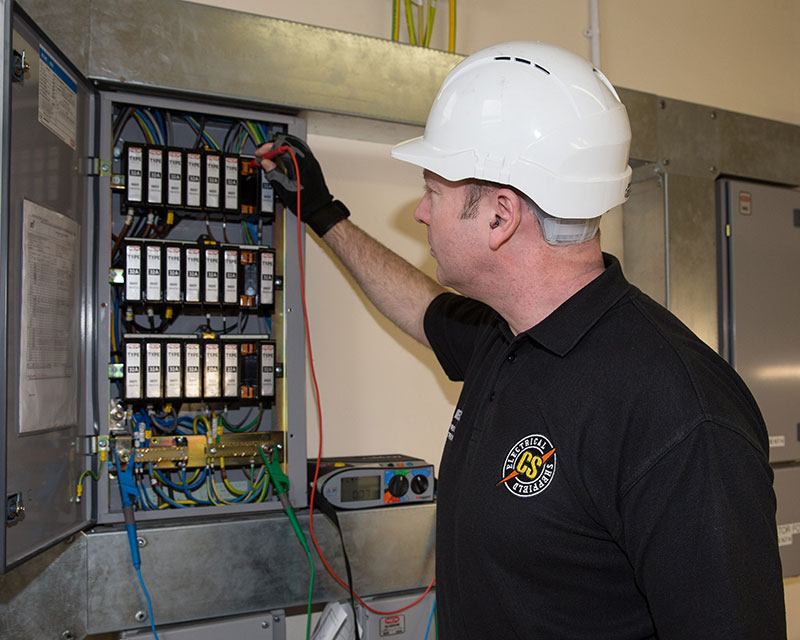 As an accredited NICEIC Approved Contractor who is ISO 9001:2008 fully compliant we offer the full range of inspection and testing of electrical fixed wire installations from initial verification on new installations to periodic inspection and testing on existing installations.
As an accredited NICEIC Approved Contractor who is ISO 9001:2008 fully compliant we offer the full range of inspection and testing of electrical fixed wire installations from initial verification on new installations to periodic inspection and testing on existing installations.
We offer fixed installation testing to ensure that your installation complies with BS7671 IET Wiring Regulations. Our electrical engineers are all fully qualified Electricians each with a minimum qualification of City & Guilds 2391 in electrical inspection & testing and are highly experienced in the inspection and testing of commercial, industrial and public sector premises.
First and foremost we will liaise with you as to the purpose for the fixed installation testing and ascertain the extent of inspection and testing to be carried out. It is our aim to minimise disruption to your premises whilst at the same time provide a thorough and professional electrical testing service.
The inspection and testing of your fixed electrical installation that we provide, ensures compliance under the Health and Safety at Work Act 1974, the Electricity at Work Regulations 1989 and the Consumer Protection Act 1987.
What our existing clients are often unaware of and raises concerns is that buildings insurance policies will be invalidated in the event of a claim if fixed electrical testing is not completed within the recommended guidelines. Depending on the environment, combined inspection and testing is usually required every 3 or 5 years. We use the latest software and top of the range 17th Edition testing equipment which is calibrated and checked for accuracy on a monthly basis so you can be confident that your installation is safe to use.
We also offer a service where we will provide CAD Electrical Network Drawings if you don’t already have them identifying the detail of your LV system in order to comply with Regulation 12 of The Electricity at Work Regulations 1989 (methods of identifying circuits).
The test results can be uploaded to our unique Overview system online giving you instant access to your CAD drawings, test results and certification.
Periodic Inspection and Testing
The purpose of periodic inspection and testing is to provide an engineering view on whether or not the installation is in a satisfactory condition where it can continue to be used safely.
A detailed visual examination of the installation is required, together with appropriate tests. The tests are mainly to confirm that the disconnection times of the electrical protective devices conform to appendix 3 of BS7671 (IET Wiring Regulations).
The periodic inspection and testing is carried out, so far as is reasonably practicable, for:
• The safety of persons and livestock against the effects of electric shock and burns.
• Protection against damage to property by fire and heat arising from an installation defect.
• Confirmation that the installation is not damaged or deteriorated so as to impair safety.
• The identification of installation defects and departures from the requirements of the Regulation that may give rise to danger.
Periodic inspection and testing is necessary because all electrical installations deteriorate due to a number of factors such as damage, wear, tear, corrosion, excessive electrical loading and environmental influences. Consequently:
• Legislation requires that electrical installations are maintained in a safe condition, and this lends itself to periodic inspection and testing.
• Licensing authorities, public bodies, insurance companies, mortgage lenders and others may require periodic inspection and testing of electrical installations.
Additionally, periodic inspection and testing should be considered in the following circumstances:
• To assess compliance with BS 7671 wiring regulations.
• On a change of occupancy of the premises.
• After additions or alterations to the original installation.
• Where there is a significant change in the electrical loading of the installation.
• Where there is reason to believe that damage may have been caused to the installation, as might be the case for example after flooding.
The Law
The Electricity at Work Regulations 1989 regulation 4(2) requires that:
“As may be necessary to prevent danger, all systems shall be maintained so as to prevent, so far as is reasonably practicable, such danger.”
The Health and Safety at Work Act 1974 puts a duty of care upon ‘duty holders’ which apply to both the employer and employee to ensure the safety of all persons using the premises and its equipment.
Frequency of Periodic Inspections
The time intervals between the recommended dates of periodic inspections require careful consideration to the type of installation and equipment, its use and operation, any known maintenance and the external influences to which it is subjected.
In short, the inspector being a competent person will apply engineering judgment when deciding upon intervals between inspection and testing an installation and may use the guidelines from table 3.2 of the IET Guidance Note 3. It can vary depending on the type of installation e.g.
• Construction sites and temporary installations – Every 3 months.
• Medical locations and caravan parks – Every 1 year.
• Industrial and places of public entertainment – Every 3 Years.
• Offices and shops – Every 5 years.
For help with your Inspection and Testing get in touch today






